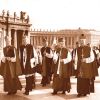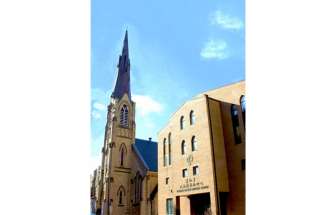Canadian influence unmistakable at Vatican II
Rome on Oct. 11, 1962, but the drama started in Canada Aug. 17 that year.
For a year and a half Cardinal Paul-Emile Leger, archbishop of Montreal, had been one of a handful of cardinals on the central preparatory commission of the council. It had met seven times between June 1961 and the feast of Pentecost, 1962. And then Leger received his book of draft documents assembled by curial officials in Rome.
Leger was not pleased with what he saw. On Aug. 17 he launched a “supplique” — a letter of petition — addressed directly to Pope John XXIII. Leger told the Pope in no uncertain terms the documents prepared in Rome were unworkable, impractical and simply wrong. They were wrong in their tone, their language and their limited vision. The council must present the traditional faith of the Church pastorally. For Leger, it was imperative the council find new modes of expression. Leger’s “supplique” eventually gathered the signatures of a number of heavyweights in the College of Cardinals.
On Sept. 17 Leger got a message back through Cardinal Amleto Cicognani, the Vatican’s Secretary of State, saying that the Pope had favourably received the supplique. How favourably became clear when the Pope opened the council on Oct. 11. Pope John XXIII immediately emphasized conciliarity by recalling that council had been throughout history the highest teaching authority in the Church. Then the Pope took a swipe at cautious, gloomy curial officials who would rather not address the modern world.
“We feel that we must disagree with these prophets of doom, who are always forecasting worse disasters, as though the end of the world were at hand,” said the Pope.
But Canadian influence on the council did not stop there.
“One of the key elements of the council is conciliarity within the Church. And one of the major voices promoting conciliarity within the council is Maxim Hermaniuk. It’s clear as night and day,” said Fr. Myroslav Tataryn, St. Jerome’s College professor of Church history.
Hermaniuk was the Ukrainian Metropolitan Archeparch of Winnipeg, and he chaired the 15-member Ukrainian Catholic delegation. He called for a permanent synod of bishops to collaborate regularly with the pope. He favoured presenting the liturgy in local languages. He fought for respect for the 21 non-Roman rites of the Catholic Church and championed the cause of ecumenism by pointing out the theological irrelevance of the mutual ex-communications between the patriarch of Rome and the patriarch of Constantinople in 1054.
As an Eastern Catholic Hermaniuk knew the spiritual and practical value of synods.
“He recognized that (synods) are not just something the Eastern Churches hold dear. It is part of the apostolic heritage,” said Tataryn. “It is the way in which the early Church operated. It doesn’t take anything away from Peter. It doesn’t take anything away from the Roman papacy. It is simply a recognition that the fullness of the Church’s life is expressed in that balance.”
He never got the permanent synod of bishops, but Hermaniuk started a conversation that goes on to this day.
“So Hermaniuk put out the proposal. It gets formulated in different ways. We still haven’t worked out how synodality works in the Catholic Church today,” said Tataryn.
German-born Canadian theologian Gregory Baum played a central role in drafting the first text on the relationship between Christians and Jews — a document that would eventually become Nostra Aetate.
Baum’s involvement began at a meeting with Cardinal Augustin Bea to discuss ecumenical relationships with non-Catholic Christians.
“At the end of the meeting Cardinal Bea said, ‘I just saw the Pope, and he said to us that he wants the secretariat to prepare a statement to rethink the Church’s relationship to the Jews,’ ” Baum recalled in an interview with The Catholic Register.
Bea was looking for experts who could contribute and Baum had published a book on the subject. From that point forward Baum worked closely with Bea.
Baum is incredulous when people suppose that somehow wily, elite, academic theologians were leading the bishops along at the council.
“These things came from the very top. The theologians were asked to help in this, to write texts and so on, but the initiative came from the top,” he said.
“It would be quite wrong to think this was run by theologians.”
Canadian bishops who had roles in helping to prepare for the council included Quebec Archbishop Maurice Roy (who was made a cardinal at the end of the council), Toronto Auxiliary Bishop Philip Pocock (who became Toronto’s archbishop in 1971), Winnipeg Archbishop George Flahiff (who was made a cardinal in 1969) and Sault Ste. Marie Bishop Alexander Carter.
Pocock was a consultor to the Commission for the Discipline of the Clergy and the Christian People. Once he held the reins in Toronto, he put his Vatican II experience into action by ordaining deacons. Pocock’s model of the revived diaconate survives to this day and is imitated all over North America.
Carter dedicated the rest of his life to lifting up the laity, creating the Diocesan Order of Service and the Diocesan Order of Women. He empowered women and native elders to preside at communion services when no priest is available, minister to the sick, witness weddings, baptize and lead wake services.
Carter was “entirely transformed by it,” said Michael Attridge, a University of St. Michael’s College theologian and historian of the council.
“He saw himself as someone who needed to implement the council in the diocese of Sault Ste. Marie in the years following,” Attridge said.
As a young priest studying canon law at The Angelicum (the University of St. Thomas Aquinas in Rome) during the council, retired Hamilton Auxiliary Bishop Matthew Ustrzycki witnessed a whole new side of the Church. The pre-Vatican seminaries of North America were not hotbeds of controversy and debate, but in Rome people were arguing theology in the street.
All the passion and idealism of the council took place against a backdrop of imminent doom. The Soviet Union had tried to install nuclear missiles just a few miles off the American coast in Cuba. Memories of the Holocaust and Europe at war were fresh. Communism and capitalism had the world divided in half.
But the Second Vatican Council wasn’t just about bishops and theologians. It addressed itself to the whole world, and Canadians took that very seriously.
“It helped us to understand the call to justice,” said Saint Paul University theologian Cathy Clifford. “That solidarity with the poor and the call to justice were an integral part of our faith commitment. I don’t hear that as much today.”
The times called forth optimism from Canadians, recalls Janet Somerville, retired general secretary of the Canadian Council of Churches.
“We were tremendously optimistic about our heritage and our future at that time,” she said. “That did condition the way we read the texts of the council.”
Canada’s middle class was growing and Catholics were joining it in record numbers. And that meant a sea change in Catholic attitudes, said Somerville.
The tragic world view of suffering immigrant Catholics was on its way out as the council convened.
“Catholics were sociologically emerging from that during the ’60s,” said Somerville. “They kind of identified the council’s agenda with their own agenda of being much more satisfied with the world — because the world was treating them better.”
Much of the Canadian history of Vatican II is still being written in how the council is interpreted. Winnipeg Archbishop James Weisgerber tells anybody who will listen that it takes 100 years to understand and implement an ecumenical council. As a historian, Attridge is trying to understand how three generations of bishops — the ones who participated in the council, the ones ordained shortly after and the bishops in place now — have interpreted Vatican II.
“It would be interesting to map the change in the Canadian bishops as we move further away from the council,” he said.
“In general, councils don’t happen very often,” said Clifford. “Even to understand what a council is and how a council deliberates is something.



